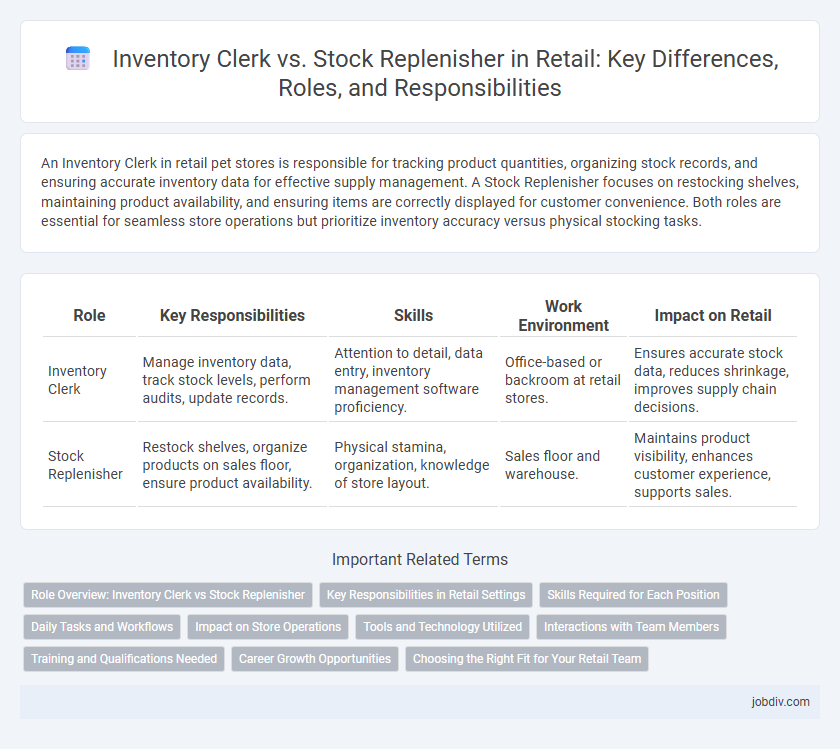An Inventory Clerk in retail pet stores is responsible for tracking product quantities, organizing stock records, and ensuring accurate inventory data for effective supply management. A Stock Replenisher focuses on restocking shelves, maintaining product availability, and ensuring items are correctly displayed for customer convenience. Both roles are essential for seamless store operations but prioritize inventory accuracy versus physical stocking tasks.
Table of Comparison
| Role | Key Responsibilities | Skills | Work Environment | Impact on Retail |
|---|---|---|---|---|
| Inventory Clerk | Manage inventory data, track stock levels, perform audits, update records. | Attention to detail, data entry, inventory management software proficiency. | Office-based or backroom at retail stores. | Ensures accurate stock data, reduces shrinkage, improves supply chain decisions. |
| Stock Replenisher | Restock shelves, organize products on sales floor, ensure product availability. | Physical stamina, organization, knowledge of store layout. | Sales floor and warehouse. | Maintains product visibility, enhances customer experience, supports sales. |
Role Overview: Inventory Clerk vs Stock Replenisher
Inventory Clerks manage accurate record-keeping, track stock levels, and ensure data integrity within retail inventory systems. Stock Replenishers focus on physically restocking shelves, maintaining product availability, and organizing merchandise for customer access. Both roles are critical to seamless inventory management but emphasize distinct operational tasks in retail environments.
Key Responsibilities in Retail Settings
Inventory clerks manage detailed records of stock levels, ensuring accurate data entry and tracking for inventory control systems in retail environments. Stock replenishers focus on physically restocking shelves, organizing products to maintain proper display and availability for customers. Both roles contribute to efficient stock management, but inventory clerks emphasize data accuracy while stock replenishers concentrate on maintaining store presentation and product accessibility.
Skills Required for Each Position
Inventory Clerks require strong organizational skills, proficiency in inventory management software, and attention to detail to accurately track stock levels and maintain records. Stock Replenishers need physical stamina, an ability to quickly navigate the sales floor, and skills in restocking items efficiently while ensuring product displays meet company standards. Both roles benefit from effective communication skills and a foundational understanding of retail operations to support seamless inventory flow.
Daily Tasks and Workflows
Inventory Clerks conduct regular audits, update inventory records, and coordinate stock reporting to maintain accurate stock levels. Stock Replenishers focus on refilling shelves, organizing products for display, and ensuring continuous product availability on the sales floor. Both roles collaborate to optimize inventory turnover and enhance retail operational efficiency.
Impact on Store Operations
Inventory Clerks enhance store operations by maintaining accurate stock records and conducting regular audits, ensuring inventory integrity and reducing discrepancies. Stock Replenishers directly impact sales by efficiently restocking shelves, preventing stockouts and improving product availability for customers. Both roles are critical for smooth store functionality, but Inventory Clerks focus on backend accuracy while Stock Replenishers prioritize front-end product accessibility.
Tools and Technology Utilized
Inventory Clerks utilize inventory management systems (IMS) and barcode scanners to accurately track and record stock levels, ensuring real-time data updates for efficient inventory control. Stock Replenishers rely heavily on handheld devices and mobile apps that interface with point-of-sale (POS) systems to monitor product availability and automate restocking processes on the sales floor. Both roles benefit from RFID technology and warehouse management software (WMS) to streamline operations, reduce errors, and maintain optimal stock levels.
Interactions with Team Members
Inventory Clerks frequently collaborate with purchasing managers and warehouse staff to ensure accurate stock records and timely order placements, facilitating seamless inventory management. Stock Replenishers coordinate closely with sales associates and floor supervisors to maintain shelf inventory levels, directly impacting customer satisfaction and sales performance. Effective communication between Inventory Clerks and Stock Replenishers enhances overall retail operations by aligning backend processes with frontline merchandising efforts.
Training and Qualifications Needed
Inventory clerks typically require formal training in inventory management software, attention to detail, and basic math skills, often supported by a high school diploma or equivalent. Stock replenishers generally need less formal education but benefit from on-the-job training that emphasizes product placement, physical stamina, and familiarity with stockroom layouts. Advanced inventory clerks may pursue certifications like Certified Inventory Specialist, while stock replenishers focus on developing efficiency and accuracy through experience.
Career Growth Opportunities
Inventory Clerks manage accurate record-keeping and data entry, which builds a foundation for roles in inventory management or supply chain analysis. Stock Replenishers focus on maintaining product availability and performing physical stock counts, providing hands-on experience that can lead to supervisory positions or warehouse management. Both roles offer career growth opportunities through skill development in logistics, inventory control, and operational efficiency within retail environments.
Choosing the Right Fit for Your Retail Team
Selecting the right inventory clerk or stock replenisher depends on your retail store's specific inventory management needs and workflow. Inventory clerks excel in maintaining accurate stock records, conducting audits, and ensuring data integrity, making them ideal for stores prioritizing detailed inventory tracking. Stock replenishers focus on efficient product restocking and shelf organization, enhancing customer experience through timely availability, which suits fast-paced retail environments emphasizing quick turnover.
Inventory Clerk vs Stock Replenisher Infographic

 jobdiv.com
jobdiv.com